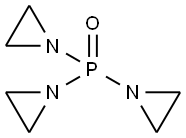| Product Name: | TEPA | | Synonyms: | Thyrotroph embryonic factor;Tris-1-aziridinylphosphine oxide or triethylene phosphoramide;1,1’,1’’-phosphinylidynetris-aziridin;1,1’,1’’-phosphinylidynetrisaziridine;1-aziridinylphosphineoxide(tris);a6366;aphoxide;cbc906288 | | CAS: | 545-55-1 | | MF: | C6H12N3OP | | MW: | 173.16 | | EINECS: | 208-892-5 | | Product Categories: | Heterocycles;Phosphorylating and Phosphitylating Agents | | Mol File: | 545-55-1.mol |  |
| Melting point | 41℃ | | Boiling point | 299℃ | | density | 1.47 | | Fp | 135℃ | | storage temp. | -20°C | | solubility | Chloroform (Sparingly), Methanol (Slightly) | | form | solid | | pka | 2.74±0.20(Predicted) | | Stability: | Stable. | | IARC | 3 (Vol. 9, Sup 7) 1987 | | EPA Substance Registry System | Aziridine, 1,1',1''-phosphinylidynetris- (545-55-1) |
| Chemical Properties | Colorless crystals. Soluble in
water, alcohol, and ether. Combustible. | | Uses | Insect chemosterilant; in dyeing, creaseproofing and flameproofing textiles; stabilizer for polymers; in photographic emulsion hardening. | | Uses | Used as insect chemosterilant; in dyeing. Antineoplastic. | | Definition | ChEBI: Tris(1-aziridinyl)phosphine oxide is a phosphoramide. | | General Description | An aqueous solution of a colorless crystalline solid. Toxic by skin absorption, ingestion or inhalation. Produces toxic oxides of nitrogen during combustion. Used as a pesticide. | | Reactivity Profile | TRIS-(1-AZIRIDINYL) PHOSPHINE OXIDE may react with aqueous solutions of acids or strong bases. Undergoes slow decomposition in water, not considered hazardous. Polymerizes violently at about 255°F. Acid fumes also cause polymerization at ordinary temperatures [USCG, 1999]. May produce highly toxic and flammable phosphine gas in the presence of strong reducing agents such as hydrides. Partial oxidation by oxidizing agents may result in the release of toxic phosphorus oxides. | | Health Hazard | Inhalation (unlikely unless a heavy mist is formed) causes symptoms similar to those observed after ingestion. Contact with liquid or powder causes irritation of eyes and (on prolonged contact) irritation and burns of skin. Burns are slow to develop and slow to heal. May sensitize on repeated contact. Ingestion causes depression, anorexia, and diarrhea, appearing 2-3 days before death, followed by terminal dyspnea, incoordination, epistaxis, salivation, prostration and cyanosis. | | Fire Hazard | Special Hazards of Combustion Products: Phosphoric acid mist may form in fire. Toxic oxides of nitrogen may form. | | Safety Profile | Poison by ingestion,
skin contact, intravenous, and
intraperitoneal routes. Experimental
teratogenic and reproductive effects.
Questionable carcinogen with experimental
carcinogenic and neoplastigenic data.
Human mutation data reported. A corrosive
irritant to the skin, eyes, and mucous
membranes. When heated to decomposition
it emits very toxic fumes of POx and NOx.
Used as an acaricide and in the permanentpress
treatment of cotton. |
| | TEPA Preparation Products And Raw materials |
|